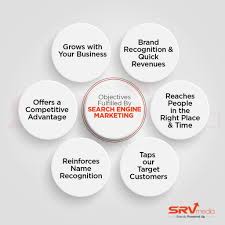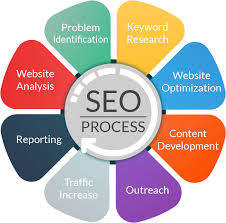Search Engine Marketing: Boosting Your Online Visibility
Search Engine Marketing (SEM) is a powerful digital marketing strategy aimed at increasing a website’s visibility in search engine results pages (SERPs) through paid advertising. It involves tactics such as pay-per-click (PPC) advertising, search engine optimisation (SEO), and other techniques to drive targeted traffic to a website.
Key Components of Search Engine Marketing:
- Pay-Per-Click (PPC) Advertising: With PPC advertising, businesses bid on keywords relevant to their target audience. Ads are displayed in search engine results when users search for those keywords. Advertisers pay a fee each time their ad is clicked.
- Search Engine Optimisation (SEO): SEO aims to improve a website’s organic search rankings by optimising its content, meta tags, and other elements. By enhancing the site’s relevance and authority, SEO helps attract more organic traffic.
- Keyword Research: Identifying relevant keywords is crucial for SEM success. By targeting the right keywords that align with user intent, businesses can reach their target audience effectively.
- Landing Page Optimisation: Creating compelling landing pages that align with ad messaging can improve conversion rates. Optimised landing pages enhance user experience and encourage visitors to take desired actions.
- Ad Copywriting: Crafting engaging ad copy that entices users to click is essential in PPC campaigns. Compelling ad copy can increase click-through rates and drive conversions.
Benefits of Search Engine Marketing:
Incorporating SEM into your digital marketing strategy offers several benefits:
- Increased Visibility: SEM helps your website appear prominently in search results, increasing visibility and attracting more potential customers.
- Precise Targeting: With SEM, you can target specific demographics, locations, and interests, ensuring your ads reach the right audience.
- Measurable Results: SEM provides detailed analytics that allow you to track performance metrics such as clicks, impressions, and conversions. This data enables you to refine your campaigns for optimal results.
- Rapid Implementation: Unlike some traditional marketing methods, SEM campaigns can be launched quickly, allowing businesses to adapt swiftly to market changes.
- Cost-Effective Advertising: With PPC advertising, you only pay when users click on your ads. This cost-effective model ensures you get value for your marketing budget.
In conclusion, Search Engine Marketing is a versatile and effective strategy for enhancing online visibility and driving targeted traffic to your website. By leveraging the power of SEM techniques such as PPC advertising and SEO, businesses can boost their online presence and achieve tangible results in today’s competitive digital landscape.
18 Frequently Asked Questions About Search Engine Marketing (SEM)
- What is SEM vs SEO?
- What are the steps for search engine marketing?
- What is search engine marketing with example?
- What is SEM and types?
- What is an example of a search engine marketing?
- What is an example for search engine marketing?
- Is search engine a marketing?
- What is difference between SEO and SEM?
- What is an example of search marketing?
- What is search engine marketing and how it works?
- What is an example of a search engine marketing ad?
- What is PPC and SEM marketing?
- What is an example of search engine marketing?
- What is search engine marketing and its types?
- What are the types of search engine marketing?
- What is meant by search engine marketing?
- Why is search engine marketing used?
- What are the different types of search engine marketing?
What is SEM vs SEO?
One common question in the realm of search engine marketing is the distinction between SEM and SEO. SEM, which stands for Search Engine Marketing, encompasses a broader set of strategies that includes paid advertising to enhance a website’s visibility in search engine results pages (SERPs). On the other hand, SEO, or Search Engine Optimisation, focuses on improving a website’s organic search rankings through optimising content and technical elements. While SEM involves paid tactics like pay-per-click (PPC) advertising, SEO is geared towards enhancing a site’s relevance and authority to attract organic traffic. Understanding the differences between SEM and SEO is crucial for businesses looking to develop an effective digital marketing strategy that combines both paid and organic approaches for optimal online visibility and performance.
What are the steps for search engine marketing?
When it comes to Search Engine Marketing (SEM), understanding the steps involved is crucial for a successful campaign. The primary steps for effective search engine marketing typically include keyword research to identify relevant terms, creating compelling ad copy that entices users, setting up targeted PPC campaigns, monitoring performance metrics, and refining strategies based on data analysis. By following these steps meticulously, businesses can enhance their online visibility, attract quality traffic, and drive conversions through SEM efforts. Each step plays a vital role in the overall success of a search engine marketing campaign, ensuring that businesses reach their target audience effectively and achieve their marketing goals.
What is search engine marketing with example?
Search Engine Marketing (SEM) is a digital marketing strategy that involves promoting websites by increasing their visibility in search engine results pages through paid advertising. An example of SEM is running a pay-per-click (PPC) campaign on Google Ads. In this scenario, businesses bid on keywords related to their products or services, and their ads appear at the top of search results when users search for those keywords. The advertiser pays a fee each time someone clicks on their ad, making it a cost-effective way to drive targeted traffic to their website and generate leads or sales. SEM allows businesses to reach a specific audience actively searching for relevant information, products, or services, thereby increasing brand exposure and potential conversions.
What is SEM and types?
Search Engine Marketing (SEM) is a digital marketing strategy that aims to enhance a website’s visibility in search engine results pages (SERPs) through paid advertising efforts. SEM encompasses various types of tactics, with the two primary categories being Pay-Per-Click (PPC) advertising and search engine optimisation (SEO). PPC advertising involves bidding on keywords and paying for each click on ads displayed in search results. On the other hand, SEO focuses on improving organic search rankings by enhancing website content and structure. Both PPC and SEO are integral components of SEM, offering businesses versatile ways to drive targeted traffic and achieve online visibility goals effectively.
What is an example of a search engine marketing?
An example of search engine marketing is Google Ads, a popular platform that allows businesses to create and display ads on Google’s search engine results pages. With Google Ads, advertisers can bid on specific keywords related to their products or services, and their ads are shown to users who search for those keywords. When a user clicks on the ad, the advertiser pays a certain amount, hence the term pay-per-click (PPC) advertising. This form of SEM enables businesses to target their audience effectively and drive targeted traffic to their websites, ultimately boosting visibility and conversions.
What is an example for search engine marketing?
An example of search engine marketing (SEM) is a company using pay-per-click (PPC) advertising on Google to promote its products or services. In this scenario, the company creates targeted ads based on relevant keywords related to their offerings. When users search for those specific keywords on Google, the company’s ads appear at the top of the search results. The company pays a fee each time someone clicks on their ad, driving traffic to their website and potentially leading to conversions. This demonstrates how SEM can help businesses increase their online visibility and reach potential customers actively searching for their products or services.
Is search engine a marketing?
The question “Is search engine marketing?” often arises due to the terminology used in digital marketing. Search engine marketing (SEM) refers to the practice of promoting websites by increasing their visibility in search engine results pages through paid advertising and optimisation strategies. While a search engine itself is not a form of marketing, it serves as the platform through which SEM techniques are implemented to reach and engage target audiences effectively. By leveraging search engines like Google or Bing, businesses can deploy SEM strategies to enhance their online presence, drive traffic to their websites, and ultimately achieve their marketing objectives.
What is difference between SEO and SEM?
When discussing Search Engine Marketing (SEM) and Search Engine Optimisation (SEO), it’s important to understand the distinction between the two. SEO focuses on improving a website’s organic search rankings through strategies such as keyword optimisation, content creation, and link building. On the other hand, SEM encompasses paid advertising tactics like pay-per-click (PPC) campaigns to increase a website’s visibility in search engine results pages. While SEO aims to enhance organic traffic over time, SEM delivers immediate results through targeted paid advertisements. Both SEO and SEM play crucial roles in boosting a website’s online presence, with SEO focusing on long-term growth and SEM providing more immediate visibility through paid channels.
What is an example of search marketing?
An example of search marketing is pay-per-click (PPC) advertising, where businesses create ads that appear at the top of search engine results pages (SERPs) based on specific keywords. When users search for those keywords, relevant ads are displayed, and advertisers pay a fee each time someone clicks on their ad. PPC campaigns allow businesses to target their audience effectively and drive traffic to their websites through paid placements in search engine results. This form of search marketing enables businesses to increase visibility, attract potential customers, and achieve measurable results through strategic keyword targeting and ad placement.
What is search engine marketing and how it works?
Search engine marketing (SEM) is a digital marketing strategy that aims to increase a website’s visibility in search engine results pages (SERPs) through paid advertising. SEM works by leveraging tactics such as pay-per-click (PPC) advertising, search engine optimisation (SEO), and other techniques to drive targeted traffic to a website. With PPC advertising, businesses bid on keywords relevant to their target audience, and their ads are displayed in search results when users search for those keywords. SEO, on the other hand, focuses on improving a website’s organic search rankings by optimising its content and other elements. By combining these strategies effectively, businesses can enhance their online presence and attract valuable traffic from search engines.
What is an example of a search engine marketing ad?
An example of a search engine marketing ad could be a text-based advertisement displayed at the top or bottom of search engine results pages (SERPs) in response to specific user queries. For instance, when a user searches for “best coffee shops in London,” they may see an ad with a headline like “Discover London’s Top Coffee Spots” accompanied by a brief description and a link to the advertiser’s website. Such ads are designed to attract users’ attention, drive traffic to the advertiser’s site, and ultimately generate leads or conversions. By strategically targeting relevant keywords and crafting compelling ad copy, businesses can effectively promote their products or services through search engine marketing ads.
What is PPC and SEM marketing?
Pay-Per-Click (PPC) and Search Engine Marketing (SEM) are integral components of digital marketing strategies aimed at boosting online visibility and driving targeted traffic to websites. PPC advertising involves bidding on keywords to display ads in search engine results, with advertisers paying a fee each time their ad is clicked. SEM encompasses a broader approach that includes PPC, as well as search engine optimisation (SEO) and other tactics to enhance a website’s visibility in search engine results pages. By understanding the nuances of PPC and SEM marketing, businesses can effectively reach their target audience, increase brand awareness, and achieve measurable results in the competitive online landscape.
What is an example of search engine marketing?
An example of search engine marketing (SEM) is a company bidding on keywords related to their products or services and creating pay-per-click (PPC) ads that appear at the top of search engine results pages (SERPs) when users search for those keywords. When a user clicks on the ad, the company pays a fee to the search engine. This targeted advertising method allows businesses to reach potential customers actively searching for specific products or services, driving relevant traffic to their website and increasing the likelihood of conversions.
What is search engine marketing and its types?
Search engine marketing (SEM) is a digital marketing strategy that aims to increase a website’s visibility in search engine results pages (SERPs) through paid advertising. SEM encompasses various types of tactics, with the two main categories being pay-per-click (PPC) advertising and search engine optimisation (SEO). PPC advertising involves bidding on keywords to display ads in search results, with advertisers paying each time their ad is clicked. On the other hand, SEO focuses on improving organic search rankings by optimising website content and structure. Both PPC and SEO are integral components of SEM, working together to drive targeted traffic and enhance online visibility for businesses.
What are the types of search engine marketing?
When it comes to Search Engine Marketing (SEM), there are primarily two main types: Pay-Per-Click (PPC) advertising and Search Engine Optimisation (SEO). PPC advertising involves bidding on keywords to display ads in search engine results, with advertisers paying a fee each time their ad is clicked. On the other hand, SEO focuses on improving a website’s organic search rankings by optimising its content and other elements to enhance visibility in search results. Both PPC and SEO play integral roles in SEM strategies, offering businesses different avenues to increase online visibility and attract targeted traffic.
What is meant by search engine marketing?
Search engine marketing (SEM) refers to a digital marketing strategy that focuses on increasing a website’s visibility in search engine results pages (SERPs) through paid advertising methods. SEM encompasses various tactics, including pay-per-click (PPC) advertising and search engine optimisation (SEO), to drive targeted traffic to a website. By strategically targeting relevant keywords and optimising ad campaigns, businesses can enhance their online presence and attract potential customers actively searching for products or services related to their offerings. SEM plays a crucial role in boosting brand visibility, driving website traffic, and ultimately improving conversion rates in the competitive online landscape.
Why is search engine marketing used?
Search engine marketing is utilised for several key reasons. Firstly, it enables businesses to increase their online visibility and reach a wider audience by appearing prominently in search engine results pages. By leveraging SEM tactics such as pay-per-click advertising and search engine optimisation, companies can attract targeted traffic to their websites and generate leads or sales. Additionally, SEM offers precise targeting options, allowing businesses to tailor their campaigns to specific demographics, locations, and interests. Furthermore, search engine marketing provides measurable results through detailed analytics, enabling businesses to track performance metrics and refine their strategies for optimal outcomes. Overall, the use of search engine marketing is essential for enhancing brand visibility, driving website traffic, and achieving marketing objectives in the digital landscape.
What are the different types of search engine marketing?
When it comes to Search Engine Marketing (SEM), there are various types of strategies that businesses can employ to enhance their online visibility and attract targeted traffic. The primary types of SEM include Pay-Per-Click (PPC) advertising, which involves bidding on keywords to display ads in search engine results, and Search Engine Optimisation (SEO), which focuses on improving organic search rankings through content optimisation and other techniques. Additionally, other SEM tactics may include display advertising, remarketing campaigns, and local search marketing. Each type of SEM offers unique benefits and can be tailored to suit specific marketing objectives and target audiences. By understanding the different types of SEM available, businesses can create comprehensive digital marketing campaigns that drive results and maximise their online presence.



